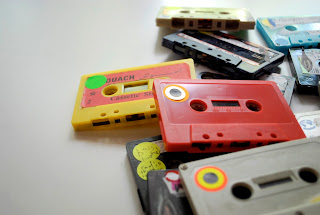Cassette Recordings
My freshman year of college centered on enrolling in all the historical music themed classes I could find (or take without a prerequisite). My favorite was entitled 'Music Since 1950'(MUS 390). It was taught and created by Dr. Keller Coker. The focus of the class, 12 musicians Dr. Coker favored. The selection process was rather complex, but even Coker (as he preferred to be called) admitted it was still a bit subjective. Even so, I was introduce to a new musical world and dug deep into the cultural charge each musician brought to their respective era or eras. I became interested in Gould, Miles, Joni Mitchell, Ornette, Ralph Towner and Oregon, Prince, and a half dozen others. The first class, Coker asked me to define music. As he asked the question, I became terrified I would be asked to answer it! I nearly botched the definition which could have cast me among the causal music listeners of the world, but like the time I was being attacked by an alligator and remembered, "tickle it's belly", I also had a positive chemical brain spill in MUS 390. I replied, "Music is sound...but people talking makes sound, so..." at which point Dr. Coker cut in, agreeing and emphasizing music (as in what we'd discuss in MUS 390) must be organized sound, to be music.
Lately, this definition, music is organized sound, has me wondering. Generally speaking, we all have some understanding of what music is and isn't. The border between non-music (or noise) is culturally based. Western ears tend to scuff at traditional sounds/songs from non-Western countries. Maybe scuff is too harsh a word, but at the very least those not exposed, think strangely about what they don't have prior reference to.
Upon listening to Aki Onda's Cassette Recordings Volume 3: South of the Border, I was doubtful I'd connect with what I'd hear. The element of chance and intent play a reversed role within field recordings and this is certainly intriguing to me, but when my wife asked what I was listening to, I began to think if field recordings are consider music? Or, should we be content and confident in saying, "I'm listening to a field recording, it's musical, like a waterfall, but not specifically music. In the case of Cassette Recordings Volume 3: South of the Border, location recordings seems more appropriate.
All field recordings found on CRV3: SOTB were recorded in Mexico. Out of the three tape cassette players Onda used, two became worn from overuse. The album contains five songs/sound collages that thrive from these imperfections.
CRV3: SOTB begins with ‘A Day of Pilgrimage.’ This piece is totally void of anything resembling music. It does, however, pulse and hiss like a storm gathering when listening with sound isolating earphones. After six minutes the aptly titled ‘Dust’ gently enters. It is a swirl of low rumbling tape distortion. I thought about my childhood spent on the Oregon Coast, watching the tide and waves play. I also remember watching dust float all around my parent’s house when the sun came through the peephole on the front door. If we could hear the sound of dust landing, we'd hear sounds represented on this track. Around the two minute mark the intensity lessens as a sound collage begins to unfold. There's a mix of machinery, clicks, brief vocal smearing, and a general return to oceanic sounds. The clicks and tape distortion is almost rhythmic. The speed of the clicks increases followed by two or three tings from bells. The tempo nearly doubles six minutes in. Background rumblings fade out and what could arguably be described as syncopation is heard from potential gears being turned and manipulated. Nearing a minute to go, a faint answering machine beep comes forth following a return to subdued button pushing, crackles, and buzz.
Track 3, ‘Bruise and Bite’, begins as static from possibly a radio and meanders to distant talking, town noises, broken silences, taps, creaking, trains to a haunted coo. There’s a definite idea existing as the song doesn't come off as chance-based as the previous two. Ideas (sounds) are revisited. Whether the background drone, the whistling New Age fog horn (?), or radio blasts, ‘Bruise and Bite's’ eerie manipulation is clearly musical and arguably organized. The song fades slowly, meeting with track four’s wheezing. 'The Sun Clings To The Earth And There Is No Darkness' contains a familiar drumming pattern leading into a military march. On the surface, this piece is most closely linked to 'music'. But once the drum march fades a third of the way through, tape head hiss moves to the front and 'The Sun Clings To The Earth And There Is No Darkness' is met with a rhythmical shift of cars, radio, and voices. The distant whine from the tape increases in noise and sounds reminiscent of weak screams. The hustle and bustle of the distant background is overwhelmed by the whirl of the tape juxtaposing the briefly heard pop radio song and soft melodic horn.
'I Tell A Story Of Bodies That Change' is the lengthiest track, clocking in at 17 and a half minutes. The damages accrued when this field recording was captured is definitely heard throughout this piece. Around the five minute mark, a sharp whine in the back, most likely caused from a worn motor, joins the meditative hum created by echoes and deep flutes. It repeats throughout and pastes itself well among the fuzz and static noise. It's a soothing piece ending with the gentle sound of distant waves rising and falling.
I don’t truly understand the why’s, what’s, or how’s to CRV3: SOTB. But Onda chose to release this field recording for others to experience. Certainly, it has value to him. And I’m interested in that as much as the overall sound. I also wonder about those individuals who will choose to actively listen to CRV3: SOTB and find meaning.
 |
| Aki Onda |




Comments
Post a Comment